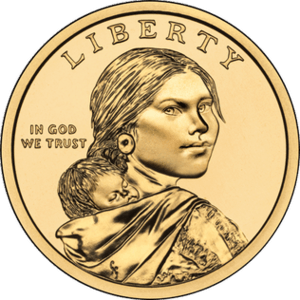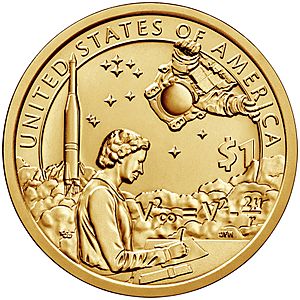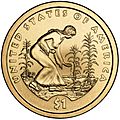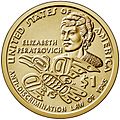Sacagawea dollar facts for kids
| United States | |
| Value | 1.00 United States dollar |
|---|---|
| Mass | 8.100 g (0.26 troy oz) |
| Diameter | 26.49 mm (1.043 in) |
| Thickness | 2.00 mm (0.079 in) |
| Edge | Plain (2000–2008) Lettered (2009–present) |
| Composition | Core: 100% Cu Cladding: 77% Cu, 12% Zn, 7% Mn, 4% Ni Overall: 88.5% Cu, 6% Zn, 3.5% Mn, 2% Ni |
| Years of minting | 2000–2001 (circulation) 2002–2008 (collectors only) 2009–2011 (circulation) 2012–present (collectors only) |
| Mint marks | P (Philadelphia) D (Denver) S (San Francisco) W (West Point, special strikings only) |
| Obverse | |
 |
|
| Design | Profile of Sacagawea with her child, Jean Baptiste Charbonneau |
| Designer | Glenna Goodacre |
| Design date | 2000, modified 2009 |
| Reverse | |
 |
|
| Design | Mary G. Ross and American Indians in the Space Program |
| Designer | Emily Damstra |
| Design date | 2019 |
The Sacagawea dollar is a special dollar coin from the United States. People sometimes call it the "golden dollar" because of its unique color. This coin has been made every year since 2000. However, it was not released for everyday use from 2002 to 2008, and again from 2012 until now. This was because it was not very popular with the public.
The coin has a core made of copper. This core is covered with a special type of brass that contains manganese, which gives the coin its golden look. The front side, called the obverse, was designed by Glenna Goodacre. From 2000 to 2008, the back side, or reverse, showed an eagle design by Thomas D. Rogers. Since 2009, the reverse of the Sacagawea dollar changes every year. Each new design shows a different part of Native American cultures and history.
Contents
Why Was the Sacagawea Dollar Created?
The idea for the Sacagawea dollar came about because people needed a new dollar coin. Before this, the Susan B. Anthony dollar was used. This coin was helpful for machines like vending machines and public transport systems. However, many people did not like its design.
At first, the Statue of Liberty was suggested for the new dollar coin's design. But in the end, Sacagawea was chosen. Sacagawea was a brave Shoshone woman who helped the Lewis and Clark Expedition explore the western United States.
How the Sacagawea Dollar Was Introduced
The U.S. Mint, which makes coins, worked hard to make the Sacagawea dollar popular. They advertised the coin on TV, radio, and in newspapers. They even partnered with big stores like Walmart and cereal companies like Cheerios to get people to use the new coin.
Despite all this effort, the Sacagawea dollar did not become widely popular. Because of this, fewer coins were made in the years after its first release. From 2007 to 2016, the Sacagawea dollar was made alongside the Presidential dollars. In 2012, the number of Sacagawea dollars made each year was greatly reduced. This happened because there were already many unused dollar coins stored away.
Special Sacagawea Dollars
The Mint once thought about making Sacagawea dollars out of real 22-karat gold. But this idea was quickly stopped because there were questions about whether the Mint had the power to make such coins. The few gold coins that were made are still owned by the Mint.
Soon after the first Sacagawea dollars were made, a few special coins were found. These coins were accidentally made with the front side of a state quarter and the normal Sacagawea dollar back side. These rare coins are very interesting to coin collectors.
Images for kids
-
2010 reverse by Thomas Cleveland honors the Haudenosaunee nation and their Great Law of Peace
-
2018 reverse by Michael Gaudioso featuring Jim Thorpe
-
2020 reverse, designed by Phebe Hemphill featuring Elizabeth Peratrovich
See also
 In Spanish: Dólar Sacagawea para niños
In Spanish: Dólar Sacagawea para niños








